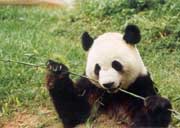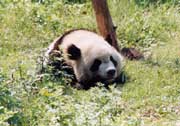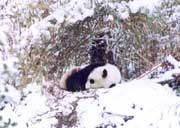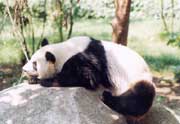|
 People still have doubts on why giant pandas choose to live on bamboos. From an ecological perspective, the specialized eating habit of the giant pandas shows that their ecological niche is very narrow, and they avoid competition by compressing the niche (compressing the width of their range food). The giant pandas just live on the food that is distributed most extensively in the North Temperate Zone, which is not nutritious but abundant and steady in reserve to live on till now, so that people think that pandas are the "winners" who can stand the long test in the evolution process, but pandas have lost the sense of competition and curiosity, so they are observing the convention and holding themselves together in the fate that has a bleak prospect. In the specialization, the giant pandas live on the bamboos that are low in nutrition and energy. In order to live, they try their best to reduce their range of activities, to exercise less and to rest more in order to save the energy. People still have doubts on why giant pandas choose to live on bamboos. From an ecological perspective, the specialized eating habit of the giant pandas shows that their ecological niche is very narrow, and they avoid competition by compressing the niche (compressing the width of their range food). The giant pandas just live on the food that is distributed most extensively in the North Temperate Zone, which is not nutritious but abundant and steady in reserve to live on till now, so that people think that pandas are the "winners" who can stand the long test in the evolution process, but pandas have lost the sense of competition and curiosity, so they are observing the convention and holding themselves together in the fate that has a bleak prospect. In the specialization, the giant pandas live on the bamboos that are low in nutrition and energy. In order to live, they try their best to reduce their range of activities, to exercise less and to rest more in order to save the energy.
1 Range of Activities (Homeland)
Compared to other carnivores that are of similar size as them, their range of activities is the smallest, it is about 4 to 7 square kilometers every year, but that of the black bears can be up to 30 square kilometers. They move about in such a small area all the year round, thus their range of activities is very small, the quantity of activities has accordingly decreased, so that they have reduced the energy spent in rushing about to look for food or drink.
The range of activities of the male "citizens" is about 6 to 7 square kilometers per year. They just move about in half of the range of the homeland per month.
The range of activities of female "citizens" is accordingly smaller than that of the male ones. It covers about 4 to 5 square kilometers and their activities are focused in one tenth of the total range of activity per month.
2 Time Schedule
Because the energy in the bamboos is very low, in order to reduce the energy consumed as much as possible, the giant pandas mainly spend their time in looking for food and resting. After eating and drinking, they will sleep after climbing to the high branches where it is safe and cool. Sometimes, the pandas will be too sleepy to climb into the trees so they will sleep on the grass, in the snow field, or on the rocks. They can go on to look for food after having a nap.
 
 
The everyday time schedule of a giant panda could be like,
00:00-02:00 Sleep 02:00-07:40 Breakfast 07:40-10:30 Morning Sleep
10:30-11:00 Playing 11:00-12:00 Lunch 12:00-14:30 Noon Break
14:30-21:00 Supper 21:00-24:00 Evening Break
So everyday they spend 54.86 % of time in looking for food, 43.06% of time for rest, but only 2.08% of time for play.

Having survived from the Quaternary glaciers, the giant panda is never afraid of cold and moisture. Even when the temperature is as low as - 4 to -14 Celsius, it still walks through the thick bamboo clumps loaded with heavy snow. Unlike black bears and many other animals, they don't hide themselves in caves and hibernate but still select and eat bamboos in the cold winter. The giant panda does not fear moisture, either. It lives in the moist forest with a degree of humidity as high as 80%. For this reason that Li Shizhen, the famous pharmacist of the Ming Dynasty, took beddings made of panda fur as a means of preventing moisture and coldness.
More Pictures......
Specialized Food
More Pictures
|